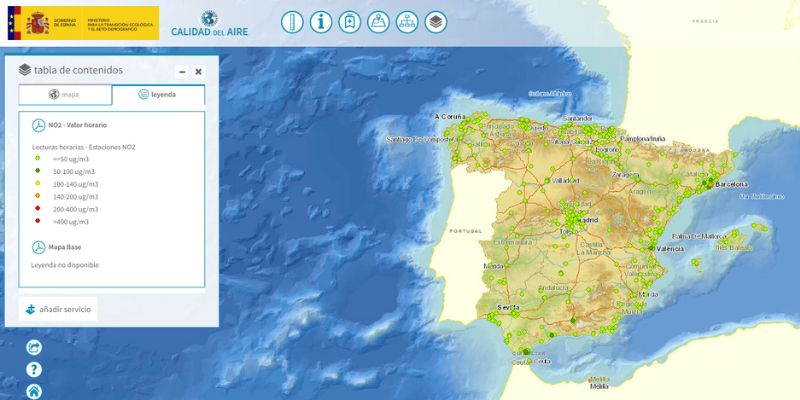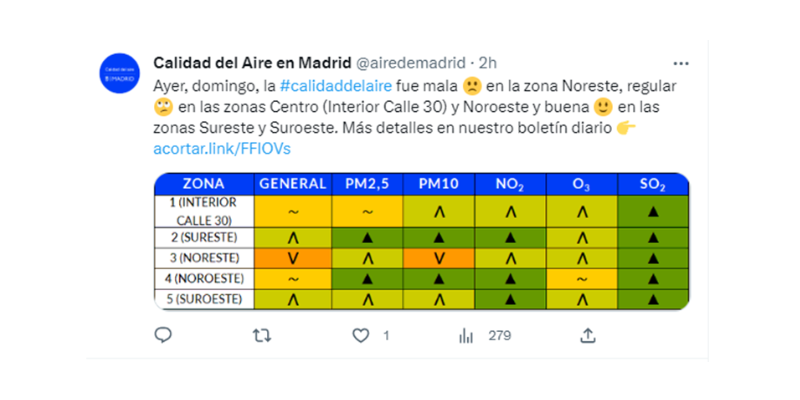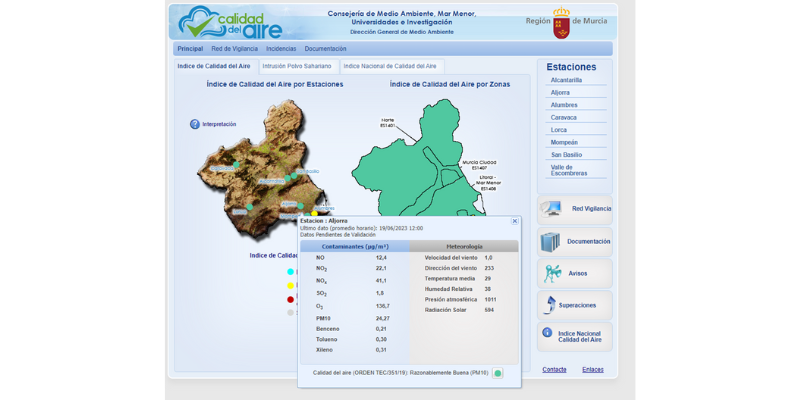Air quality is an issue of growing concern around the world and Spain is no exception. To know whether air quality is good or bad, it is important to understand which pollutants directly influence it and where to obtain relevant and reliable information on the state of the air we breathe.
What is air quality?
Air quality refers to the presence of pollutants and harmful substances in the atmosphere that affect both human health and the environment.
The main air pollutants include substances such as:
- Nitrogen dioxide (NO2): Mainly produced by the combustion of fossil fuels in vehicles and industrial processes. Can irritate the airways and contribute to respiratory and cardiovascular problems.
- Particulate matter (PM10 and PM2.5): Small solid or liquid particles in the air. They come from a variety of sources, including fuel combustion, industrial emissions and dust. They can enter the lungs and cause respiratory problems as well as affecting general air quality.
- Ozone (O3): Formed when pollutants react with sunlight. High levels of ozone can irritate the lungs and airways, especially in people with chronic respiratory diseases.
- Sulphur dioxide (SO2): Produced by burning fossil fuels, mainly in industry and power generation. Can cause respiratory irritation and contribute to respiratory and cardiovascular problems.
- Carbon monoxide (CO): Produced by the incomplete combustion of fossil fuels. Exposure to high concentrations can be fatal as CO reduces the oxygen-carrying capacity of the blood.
These pollutants can be emitted from a variety of sources (industry, traffic, daily activities…) and a high concentration of them in the atmosphere, especially those considered toxic or harmful, can have negative effects on the respiratory and cardiovascular health of those exposed, as well as adverse effects on ecosystems and the climate.
How is air quality measured?
Air quality is assessed by monitoring the concentration of air pollutants at different locations. This is done using air quality monitoring networks, which consist of stations with specific monitoring instruments that record continuous and real-time data on the main pollutants.
So, what is a good air quality?
Limit values and standards set by national and international bodies are used to determine whether air quality is good or bad.
The regulations define the maximum permitted concentrations of pollutants (limit value) and the maximum number of times a pollutant may exceed the limit value (exceedance). In the case of Spain, all these data are set out in Royal Decree 102/2011.
Air quality index
The Air Quality Index (AQI) is a measure used to assess and communicate air quality in a given area in a simplified and understandable way.
It provides an overview of air quality as a function of the concentration of air pollutants in the ambient air.
The AQI is calculated from data on concentrations of NO2, PM10 and 2.5 particulate matter, ozone, SO2 and CO; the measured values of the pollutants are compared with standards and, based on this comparison, an AQI score is assigned to indicate the air quality in that particular area.
The AQI usually gives values in different categories ranging from “good”, “quite good”, “moderate”, “unfavourable” or “very unfavourable”.
When the AQI indicates ‘good’ air quality, it means that pollution levels are within acceptable limits and do not pose a significant risk to health. On the other hand, if the AQI indicates “unfavourable” or “very unfavourable” air quality, it means that pollution levels exceed the established limits and may represent a risk, especially for sensitive groups such as children, the elderly or people with respiratory diseases.
Resources and air quality map
In order to know whether the air quality is good or bad, the responsible authorities usually publish regular reports and updates on official websites, mobile applications and other communication channels accessible to the public.
Some examples of where you can check air quality are:
MITECO: The Ministry for Ecological Transition and the Demographic Challenge has an air quality viewer to consult information at national level, both in real time and its historical evolution.

AEMET: Provides information on air quality in different regions of Spain through its official website.
Municipal websites and applications
Many Spanish cities have their own websites and applications that provide information on air quality in their area:
Madrid air quality: On its air quality portal, Madrid City Council provides a map of the Madrid municipality with visual and easy-to-understand information on air quality and air pollutants recorded in real time at the 24 monitoring stations that make up the network.
Madrid also informs about exceedance alerts via SMS, the mobile application “Aire de Madrid” and Twitter:

Air quality in Barcelona: In the case of Barcelona, its website offers an air quality map where we can see the state of air quality according to nitrogen dioxide or PM10 particles.
Air quality in Valladolid: Valladolid City Council provides this web page with real-time data from the 5 stations that make up the Valladolid City Council Air Pollution Control Network (RCCAVA).
Air quality in Murcia: The website of the Regional Ministry of the Environment of the Region of Murcia provides data on pollutants and meteorology at most of the 7 air quality monitoring stations.

After all, knowing whether the air quality is good or bad is essential if you are to make preventive decisions, such as wearing a mask to filter particles or avoiding exercising in a certain area. Check national or local websites to find out what the air quality is like today.










